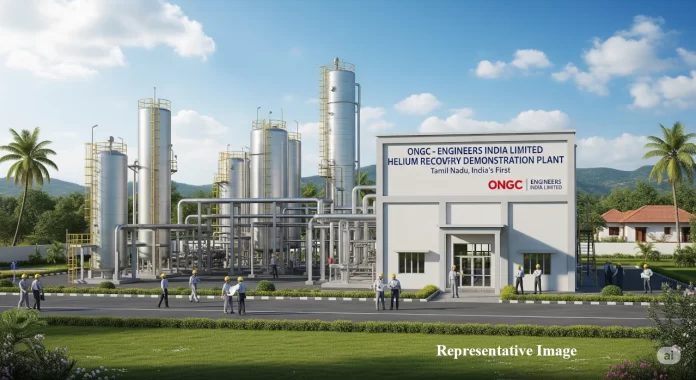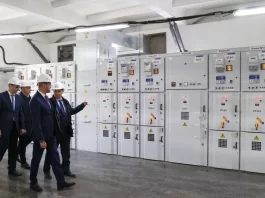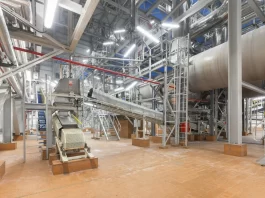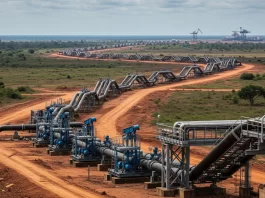With the signature of a significant agreement between Engineers India Limited (EIL) and the ONGC Energy Centre Trust (OECT), the research and development arm of Oil and Natural Gas Corporation Limited (ONGC), India is poised to enter a new era in critical energy and technology resources. The two organizations formalized their collaboration on August 18, 2025, to establish the country’s first-ever Helium Recovery Demonstration Plant at ONGC’s Kuthalam Gas Collection Station in the Cauvery Asset, Tamil Nadu.
This initiative is regarded as a transformative step in reducing India’s reliance on helium imports while also enhancing the strategic depth of the nation’s industrial and technological ecosystem. The initiative is in complete alignment with the government’s vision of a self-sufficient India, as outlined in the Atmanirbhar Bharat mission.
Agreement’s Scope
The agreement between OECT and EIL delineates a comprehensive set of responsibilities that encompass the entire project lifecycle. The technical, financial, and operational foundation of the initiative will be established during the initial stage by compiling a Detailed Project Report (DPR). The team will create a Basic Engineering Design Package (BEDP) after completing this preliminary work. This package serves as a guide for the transformation of technical concepts into practical design strategies.
The collaboration extends beyond the design phase to the full-scale execution of projects under an EPCM and Supply model. This encompasses all of the main tasks, including the critical process of commissioning the plant for operations, procurement of materials and equipment, comprehensive design and engineering, and construction of the plant. The plant’s operations will be rigorously tested to ensure their efficiency and reliability prior to their introduction into commercial service during the final stage.
The total value of the agreement is ₹39.42 crore, which includes the applicable GST. The commitment of all parties involved is underscored by the expectation that the facility will be completed within a tight timeframe of 18 months, as demonstrated by the clearly defined project schedules and deliverables.
Technology Backbone
The advanced technological package developed by the CSIR–Indian Institute of Petroleum (CSIR-IIP), a prominent research institute under the Council of Scientific and Industrial Research, is the foundation of this pioneering endeavor. This technology has been validated at the laboratory and pilot levels and is specifically designed to facilitate the recovery of ultra-pure helium from natural gas streams.
The new demonstration facility at Kuthalam is engineered to process 750 Nm³/hr of natural gas, guaranteeing an impressive throughput and yield. It is adaptive and robust, capable of operating at 110% of its design capacity when necessary. The plant’s primary output will be Grade-A Helium with a purity of 99.995%, which is in compliance with international industrial and scientific standards. India can meet its domestic requirements without compromise by using this high-grade helium for a variety of cutting-edge applications.
Helium’s Strategic Significance
The global community acknowledges helium as a critical and irreplaceable resource. Although frequently overlooked, it is essential in a variety of high-tech applications that serve both civilian industries and strategic domains.
Helium is essential for the pressurization and purging of rocket propellant systems, the support of satellite launches, and the facilitation of space research in aerospace and space exploration programs. The semiconductor industry, which is a critical sector of contemporary economies, depends on helium to establish stable and inert manufacturing environments that prevent contamination during chip fabrication. The fiber optics industry is dependent on this property, as it facilitates the precision procedures necessary for the production of high-speed communication cables.
Helium is perhaps most well-known for its use in cryogenics, where it is used to cool superconducting magnets in MRI machines, thereby assuring life-saving medical diagnostics. Similarly, helium’s utility is extended to defense technologies, where it is utilized in strategic applications, advanced detection systems, and cooling mechanisms.
At present, India is susceptible to price fluctuations, supply chain constraints, and geopolitical uncertainties due to the fact that it imports nearly all of its helium needs. In addition to reducing foreign dependence, this project is a strategic safeguard for national security and technological advancement. India is making a deliberate pivot toward self-reliance in helium by pursuing this project.
Challenges and the Global Helium Landscape
Helium is a scarce and finite resource on a global scale, with an estimated global resource of approximately 40 billion cubic meters. Demand and supply are in close alignment, resulting in a narrow and frequently volatile market equilibrium. The current annual global production capacity is approximately 175 million cubic meters.
The United States, which has been the main producer of helium in the past, is responsible for a substantial portion of the output from natural gas sources. However, its significance has decreased as a result of the depletion of its Federal Helium Reserve. Qatar, Algeria, Russia, and emerging contributions from countries such as China and Canada are currently the main helium production centers. Recent sanctions and import restrictions, such as the European Union’s prohibition on helium imports from Russia, have significantly affected global trade flows, rendering the geopolitical landscape surrounding helium supply complex.
The demand for helium is expected to increase substantially, with a compound annual growth rate (CAGR) of approximately 5.7%, as it is projected to double to approximately 322 million cubic meters by 2035. The primary driver of this expansion is the expansion of semiconductor manufacturing applications, which have recently surpassed traditional dominant uses such as medical MRI imaging. The semiconductor industry alone is responsible for nearly 24% of the global helium demand, underscoring the critical significance of helium in the development of next-generation electronics.
Additional demand is generated by applications in aerospace, cryogenics (including quantum computing and particle accelerators), fiber optic manufacturing, and leak detection (particularly for electric vehicle batteries and fuel containers). Technological innovation is also facilitating the reclamation and recycling of helium; however, it is improbable that these measures will entirely counteract the anticipated increase in consumption.
Supply constraints continue to be a global issue. Helium production necessitates specific natural gas fields with commercially viable helium concentrations, which are scarce. The shortages are further exacerbated by the delayed development of new helium sources, the lack of supply diversification, and the downtime in main liquefaction plants. This tight supply-demand scenario has resulted in price volatility and supply risks on a global scale, prompting a resurgence of exploration efforts and investments in helium extraction technologies, such as membrane and Pressure Swing Adsorption (PSA) methods, which provide more cost-effective alternatives to cryogenic separation.
India’s initiative to establish an indigenous helium recovery demonstration facility is not only timely but also strategically imperative in this context. This places India in a small group of countries that are actively addressing supply issues by developing their own methods of extracting helium from natural gas. This serves to fortify India’s economy and technology in a competitive global market.
The Contribution of ONGC to Self-Sufficiency
The demonstration facility is a direct reflection of India’s longtime vision for a self-sufficient India. ONGC is not only furthering scientific research but also establishing the foundation for full-scale industrial deployment in the future by demonstrating the successful recovery of helium from domestic natural gas sources.
This effort is a significant milestone in ONGC’s overarching objective of delivering “Energy Now and Next,” a vision that prioritizes the integration of the traditional strengths of oil and gas exploration with forward-thinking investments in tomorrow’s technologies. ONGC’s readiness to embrace a diverse and innovative energy future is demonstrated by its development of local expertise in the extraction of uncommon and valuable gases.
Expertise and Collaboration
The initiative is distinguished by its objectives and the collaboration that serves as its foundation. The ONGC Energy Centre Trust (OECT) is responsible for leading research and development initiatives in frontier areas, including renewable energy, fuel cells, and, most recently, rare gases. By spearheading the establishment of this demonstration facility, OECT ensures the transformation of academia and cutting-edge science into practical industrial applications.
One of the most esteemed public-sector engineering firms in the country, Engineers India Limited (EIL), is providing support to OECT. EIL possesses the requisite technical and project management expertise to guarantee the successful completion of intricate energy projects in India and abroad, spanning decades.
The CSIR–Indian Institute of Petroleum (CSIR-IIP) has developed the technology bundle that facilitates helium recovery, thereby completing this triad. Its function is to guarantee that this endeavor is not reliant on imported expertise but rather is firmly rooted in Indian innovation. OECT, EIL, and CSIR-IIP symbolize the convergence of India’s most exceptional scientists, engineers, and industrialists.
A Significant Development in the Energy Sector of India
A watershed moment in India’s energy and science landscape is anticipated with the establishment of the Helium Recovery Demonstration Plant at Kuthalam. It serves as evidence of India’s technical proficiency in the extraction and refining of one of the most challenging elements to recover. Furthermore, it facilitates the development of prospective commercial-scale facilities in other natural gas fields across the nation.
This initiative will result in increased resilience in sectors as diverse as electronics and space exploration within India’s industrial ecosystem. It indicates a decrease in import dependence and an enhancement in energy security for policymakers. For ONGC and its collaborators, it represents yet another significant achievement in their pursuit of leadership in frontier energy technologies.
In the long term, the initiative could also allow India to contribute to the global helium supply chain, which has experienced frequent supply disruptions and shortages in recent years, in addition to meeting domestic demand. India would be among the few nations with indigenous helium recovery capabilities if this trajectory were to be followed.
In conclusion,
The OECT–EIL agreement for the Helium Recovery Demonstration Plant is not merely a corporate initiative; it is a strategic national step. India is establishing the groundwork for long-term energy and technology security by utilizing its domestic natural gas resources to extract helium.
This initiative serves as evidence of India’s expanding capabilities in cutting-edge technology and emphasizes the value of collaboration among research, engineering, and industry. The plant is ensuring that India is future-ready in emerging scientific and industrial domains by providing a clean stream of ultra-high purity helium, which is addressing short-term requirements.
In essence, this project represents India’s transition from a technology importer to a technology innovator and producer, thereby bolstering the nation’s trajectory toward global leadership in advanced energy and material sciences.






